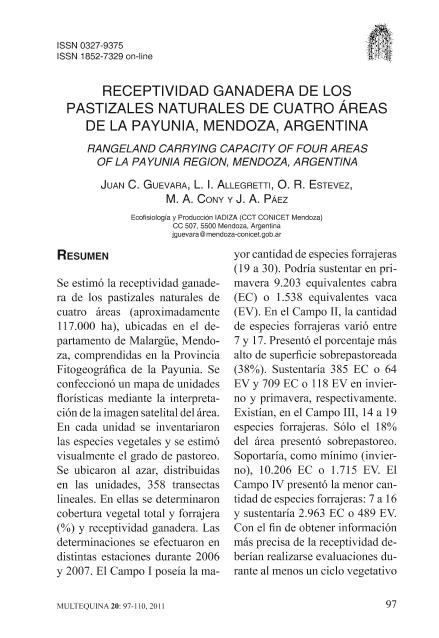Artículo
Se estimó la receptividad ganadera de los pastizales naturales de cuatro áreas (aproximadamente 117.000 ha), ubicadas en el departamento de Malargüe, Mendoza, comprendidas en la Provincia Fitogeográfica de la Payunia. Se confeccionó un mapa de unidadesflorísticas mediante la interpretación de la imagen satelital del área. En cada unidad se inventariaron las especies vegetales y se estimó visualmente el grado de pastoreo. Se ubicaron al azar, distribuidas en las unidades, 358 transectas lineales. En ellas se determinaron cobertura vegetal total y forrajera y receptividad ganadera. Las determinaciones se efectuaron en distintas estaciones durante 2006 y 2007. El Campo I poseía la mayor cantidad de especies forrajeras(19 a 30). Podría sustentar en primavera 9.203 equivalentes cabra (EC) o 1.538 equivalentes vaca (EV). En el Campo II, la cantidad de especies forrajeras varió entre 7 y 17. Presentó el porcentaje más alto de superficie sobrepastoreada (38%). Sustentaría 385 EC o 64 EV y 709 EC o 118 EV en invierno y primavera, respectivamente. Existían, en el Campo III, 14 a 19 especies forrajeras. Sólo el 18% del área presentó sobrepastoreo. Soportaría, como mínimo (invierno), 10.206 EC o 1.715 EV. El Campo IV presentó la menor cantidad de especies forrajeras: 7 a 16 y sustentaría 2.963 EC o 489 EV. Con el fin de obtener información más precisa de la receptividad deberían realizarse evaluaciones durante al menos un ciclo vegetativo(otoño-invierno y primavera-verano). Las características de las unidades florísticas de cada campo y el estudio de composición de la dieta de los herbívoros realizado en el área de estudio permitieron recomendar las especies de ganado más adecuadas para su aprovechamiento. The rangeland carrying capacity of four fields (about 117,000 ha), located in the Malargüe department, Mendoza was estimated. These areas were included in "La Payunia" phytogeographic province. A floristic unit map was made through the interpretation of the area satellite image. An inventory of plant species was made in each unit and also the grazing degree was visually estimated. Linear transects (358) were distributed at random in the floristic units. The total plant and forage plant cover (%) and the carrying capacity were determined in each floristic unit. These determinations were made in different seasons during 2006 and 2007. The Field I had the greater number of forage species (19 to 30). It could sustain 9,203 goat equivalents (GE) or 1,538 cow equivalents (CE) in spring. In the Field II the number of forage species varied from 7 to 17. It presented the greater percentage of overgrazing area (38%). It could sustain 385 GE or 64 CE and 709 GE or 118 CE in winter and spring, respectively. The Field III had from 14 to 19 forage species. Only the 18% of its area was overgrazing. It could sustain as a minimum (winter) 10,206 GE or 1,715 CE. The Field IV presented the lower number of forage species (7 to 16). It could sustain 2,963 GE or 489 CE. For obtaining more accurate information on the carrying capacity, the evaluations should be made at least during one vegetative cycle (fall-winter and spring-summer). The characteristics of the floristic units of each field and the study of the herbivore diet composition carried out in the study area permitted to recommend the livestock species more adequate for the field use.
Receptividad ganadera de los pastizales naturales de cuatro áreas de la Payunia, Mendoza, Argentina
Título:
Rangeland carrying capacity of four areasof la Payunia region, Mendoza, Argentina
Guevara, Juan Carlos ; Allegretti, Liliana Inés; Estevez, Oscar Roberto
; Allegretti, Liliana Inés; Estevez, Oscar Roberto ; Cony, Mariano Anibal
; Cony, Mariano Anibal ; Paez, Jesús Antonio
; Paez, Jesús Antonio
 ; Allegretti, Liliana Inés; Estevez, Oscar Roberto
; Allegretti, Liliana Inés; Estevez, Oscar Roberto ; Cony, Mariano Anibal
; Cony, Mariano Anibal ; Paez, Jesús Antonio
; Paez, Jesús Antonio
Fecha de publicación:
12/2011
Editorial:
Instituto Argentino de Investigaciones de las Zonas Aridas
Revista:
Multequina
ISSN:
0327-9375
e-ISSN:
1852-7329
Idioma:
Español
Tipo de recurso:
Artículo publicado
Clasificación temática:
Resumen
Archivos asociados
Licencia
Identificadores
Colecciones
Articulos(IADIZA)
Articulos de INST. ARG DE INVEST. DE LAS ZONAS ARIDAS
Articulos de INST. ARG DE INVEST. DE LAS ZONAS ARIDAS
Citación
Guevara, Juan Carlos; Allegretti, Liliana Inés; Estevez, Oscar Roberto; Cony, Mariano Anibal; Paez, Jesús Antonio; Receptividad ganadera de los pastizales naturales de cuatro áreas de la Payunia, Mendoza, Argentina; Instituto Argentino de Investigaciones de las Zonas Aridas; Multequina; 20; 2; 12-2011; 97-110
Compartir



